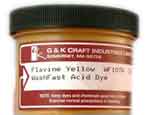Does soy fabric require an acid dye or fiber-reactive?
Does soy fabric require an acid dye or fiber-reactive?
Name: Amy


Message: Have you ever dyed soy fabric? I'm curious, would it require an acid dye or fiber-reactive? Granted it's not from an animal, but it is a protein fiber. I haven't found anything conclusive from my research. What do you think? Thank you so much, if you find the time to respond. And if you don't, thank you *thank you, for the wealth of information you provide on your website.
Blessings!
—ADVERTISEMENT—
Washfast Acid dyes
at Paradise Fibers

Washfast Acid dyes
Also known as Nylomine dyes, excellent for use on nylon. One ounce of dye will dye six pounds of fiber!
at Paradise Fibers

Washfast Acid dyes
Also known as Nylomine dyes, excellent for use on nylon. One ounce of dye will dye six pounds of fiber!
Country or region: North Carolina
Message: Have you ever dyed soy fabric? I'm curious, would it require an acid dye or fiber-reactive? Granted it's not from an animal, but it is a protein fiber. I haven't found anything conclusive from my research. What do you think? Thank you so much, if you find the time to respond. And if you don't, thank you *thank you, for the wealth of information you provide on your website.
Blessings!
Soy fiber is an interesting case, because normally we think of all plant fibers as cellulose fibers. So many sources distinguish between cellulose plant fibers and protein animal fibers! However, the fact that soy fiber is made from the protein of the soybean makes it chemically much more similar to real silk. Just like silk, soy protein fiber can be dyed with your choice of either acid dyes or fiber reactive dyes.
We don't use fiber reactive dyes with soda ash on wool, but both silk and soy protein fiber are fine with fiber reactive dyes and soda ash. They are both less sensitive to the high pH of the soda ash, which damages the texture of wool. I've found Remazol fiber reactive dyes, such as the ProChem Liquid Reactive Dyes, work well on soy protein fiber.
Of course, acid dyes are also ideal for any protein-based fiber; you may be able to get more intense colors on soy with acid dyes than with fiber reactive dyes. Acid dye should probably be your first choice. Many dyers choose acid dyes for dyeing soy protein fiber. I've seen brilliant results obtained with Jacquard Acid Dye; the WashFast Acid dyes and the Lanaset dyes should work at least as well. In my experience, food coloring does not work nearly as well, as an acid dye, on soy protein fiber or milk protein fiber, as it does on real silk, but then, food coloring is not the best dye for textiles.
Unfortunately, soy protein fiber tends to dye a bit less brilliantly than real silk, regardless of dye type. Not all soy protein fiber will dye equally well. Part of the processing used to turn soybean proteins into a textile fiber can include the chemical reaction called acetylation, which is similar to the process that turns readily-dyeable viscose rayon into difficult-to-dye rayon acetate. It would be wise to test-dye a small amount of any soy-based fiber before investing in a large quantity of it, to be sure that it is as easily dyeable as you wish. Real silk and wool remain the best fibers to dye with acid dyes, in my opinion.
Also see:
Posted: Saturday - July 31, 2010 at 11:19 AM
Follow this blog on twitter here.
Quick Links
- All About Dyes & Dyeing Top -
- Top of this blog -
- FAQ -
- The Dye Forum -
- How to Tie Dye - How to Batik -
- Books - Toys - Plants -
- Top of this blog -
- FAQ -
- The Dye Forum -
- How to Tie Dye - How to Batik -
- Books - Toys - Plants -
More in this category:
- -
Statistics
Total entries in this blog:
Total entries in this category:
Published On: Aug 29, 2012 02:49 PM
Total entries in this category:
Published On: Aug 29, 2012 02:49 PM